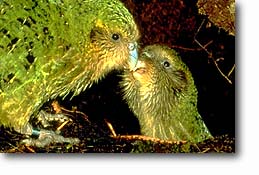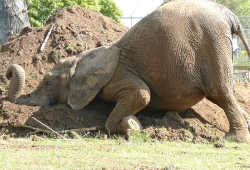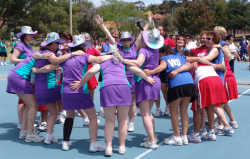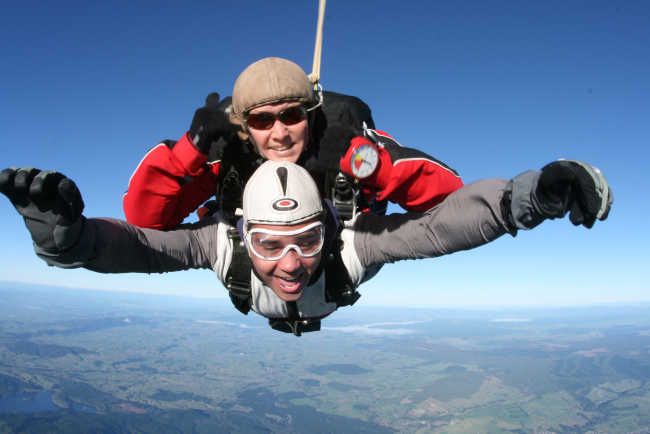Lynley Hargreaves – 12/04/02
|
|
| Mother kakapo feeding her chick Photo source DoC |
Kakapo, New Zealand’s rare parrots, have hatched an amazing twenty three chicks so far this season — boosting their population to seventy five.
These unusual birds are the world’s heaviest parrots, look like owls and forage at night. They also cannot fly, smell like papaya and breed only every few years.
Staying perfectly still in the bush was a good survival strategy when kakapo’s only predators were the enormous Haast eagles; people have been within a foot of kakapo and not noticed them because of their mottled moss-green feathers.
But when Maori arrived about a thousand years ago with rats, dogs and a liking for kakapo feathers and meat, the population plummeted. Ferrets and stoats, introduced by European settlers in the nineteenth century, pushed the birds further into the backblocks of New Zealand.
In 1870 the birds were billed as "doomed to certain extinction" and by 1977 they seemed technically extinct. Searches of the inaccessible Fiordland mountains turned up eighteen birds, but all were male.
That same year, though, a surprise population was discovered in the dense bush of Stewart Island. But even these birds were on the way out – as prey to feral cats.
So all the remaining kakapo were rounded up and sent to island sanctuaries: Codfish/Whenua Hou, near Stewart Island; Maud, in the Marlborough Sounds; and Little Barrier, in the Hauraki Gulf.
On those islands workers from the Wildlife Service and then the Department of Conservation (DoC) struggled to get birds breeding, and keep chicks alive. Success was patchy, the population hovering around fifty to sixty birds. Until now.
In past weeks, DoC workers and a legion of volunteers struggled to keep up with breeding birds. Female kakapo raise their chicks on their own, and at night they leave their nest to forage for food. So, each evening, minders slog up muddy hills for hours carrying car batteries to recharge equipment at the nests.
"I found it quite challenging," said DoC new organisms officer Verity Forbes. “You probably get three to four hours sleep a night.”
The minders, holed up about fifty metres from the nest, watch infrared camera images when a doorbell rings to tell them the bird has left her nest. The bird wears a radio tracking device, and minders have cell-phones and egg
warmers on hand. "It’s real Kiwi ingenuity stuff," said Ms Forbes.
Another innovation, seldom used, is a boom box that makes low frequencies "woomps" to imitate (and stimulate) kakapo’s strange breeding behaviour. The birds are solitary, but when it’s time to breed the males gather on a rise,
form elaborate ‘track and bowl’ systems, and make loud booming noises to attract females, sometimes for weeks.
The biggest factor in this season’s success is the large amount of fruit on rimu trees, kakapo recovery project leader Paul Jansen said. "It’s a better than twenty year event." In spring, female birds leave their home ranges and take a ‘food tour’ around the island, sampling the unripe berries. If satisfied, they lay eggs.
Human intervention has helped, too. Whenua Hou was declared predator-free two years ago, and birds are fed a special supplementary diet of egg protein, spirulina, and walnut essence.
But if you feed them too much the birds can produce too many male chicks — about seven males for every three females. If birds are in poor condition, this ratio is reversed. More females are desirable, since they’ve always been in short supply in the captive kakapo population, Mr Jansen says. So the trick is to get the birds used to taking the food without giving them too much.
DoC will be aiming for a less hands-on approach in coming years, when the birds can live on an island without human intervention. For that, they’re going to need other islands — kakapo need lots of space, and after this year’s success story Whenua Hou is almost full.





